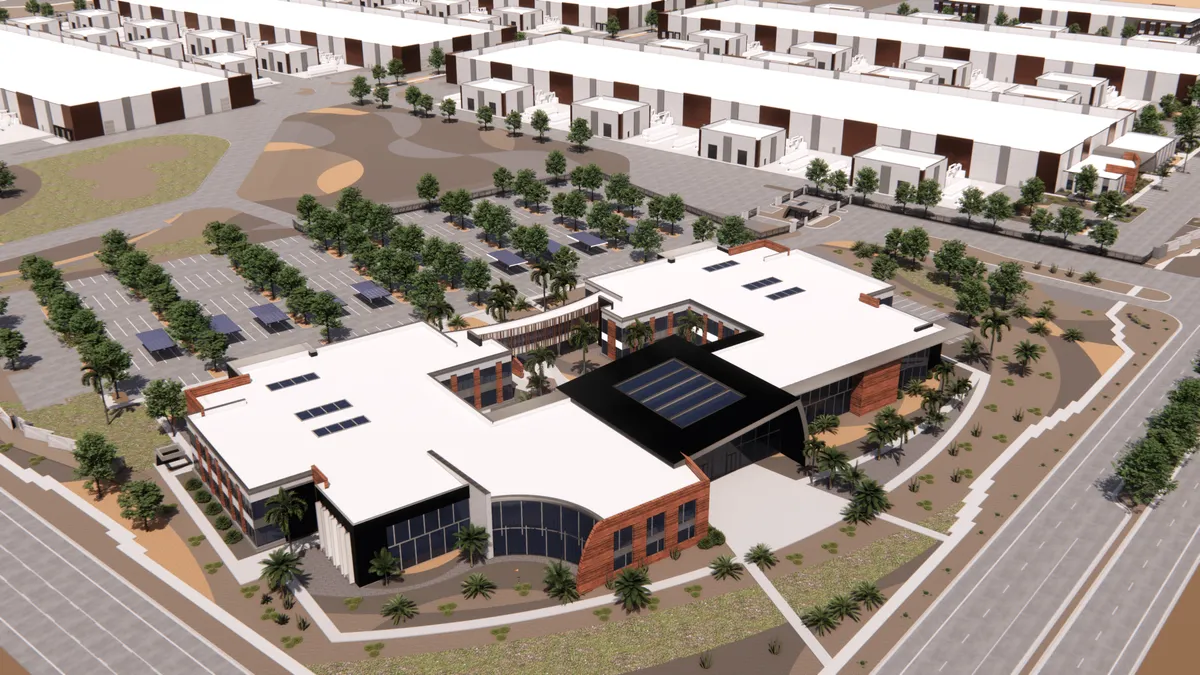Contractors finally got the news they had been waiting on, a rate cut that could rouse the sleeping construction market.
The Federal Reserve cut its benchmark interest rate by 25 basis points on Wednesday afternoon. The move should provide the construction industry with a much-needed confidence boost and push nearly ready projects across the starting line.
More importantly, it could “finally wake up the bear from its slumber,” said Scott Lyons, the commercial core market leader at DPR, a Redwood City, California-based general contractor.
Nonresidential construction spending slipped in July and trails last year’s level by 1.1%, according to the most recent available data. Builds financed with private funds have largely struggled, though data center construction continues to boom.
“Some mixed-use and hospitality projects should move forward with an occasional Class A+ office,” Lyons told Construction Dive. “We have been seeing an uptick in tenant improvement projects for the fall quarter, which shows there’s some budding momentum.”
But contractors say one cut will not reset the market, especially with labor costs and trade policy crosswinds still in play. For DPR, meaningful activity will only arrive with a series of cuts that steadily ease pressure on developers, said Lyons.
“Although a cut of 25 basis points is a good start, we don’t believe this first cut will be enough to start the engine,” Lyons told Construction Dive. “We believe it will take a series of cuts in order to get some deal momentum underway.”
Other contractors feel the same way.

For example, Granger Hassmann, regional president at Adolfson & Peterson, a Minneapolis-based general contractor, said though the decision is a step in the right direction, it remains hard to say if there will be any immediate impact on the private market.
“From where we stand, it might help projects that were on the edge of being financially viable, but one small rate cut on its own probably won’t lead to a big global shift just yet,” Hassmann told Construction Dive. “If this is the start of a trend, though, we could start to see more activity and movement in privately funded projects.”
Nevertheless, the cut will allow certain projects to issue a notice to proceed, said Robert Brown, CEO of GCM Contracting Solutions, a Fort Myers, Florida-based general contractor. Projects with capital-ready owners, lender terms substantially set, permits and design in advanced stages and a delivery partner already engaged are most likely to cross into the construction phase soon, he added.

“Rate cuts help at the margins, but in our world it’s not a magic switch,” Brown told Construction Dive. “Owners who were already within reach may use this as the moment to green light.”
Value of strong teams, further cuts
Brown said though a cut can get owners off the sidelines, what really will shorten timelines today is the team put around the project. Lyons agreed, adding firms that jump in now are best advised to bring contracting partners to the table to assess labor availability as early as possible.
“The labor market is the wild card,” said Lyons. He added even if lower interest rates jumpstart demand for new projects, the cost of labor could quickly diminish the savings from lower borrowing costs.
Contractors in Florida see the rate cut as overdue, but worry the bigger picture is still uneven, said Peter Dyga, president and CEO of Associated Builders and Contractors Florida East Coast Chapter. Most commercial builders remain busy today, but are a bit more wary regarding backlog a year or more out.
That’s where cheaper borrowing could make a difference, said Dyga.

“I think this rate cut is just going to do wonders, certainly for the economy,” Dyga told Construction Dive. “Probably not as big a cut as we like, but we know how they can stack up over time in terms of the reductions.”
Contractors expect further rate cuts before the end of 2025 to unlock even more activity. The Fed will announce interest rate decisions again at the end of October and early December.
“A cut often has a psychological impact. It boosts confidence,” said Brown. “Even if the math only changes slightly, it can make owners feel better about taking the plunge. That’s important in construction, because sentiment and timing drive just as much as numbers on a spreadsheet.”























